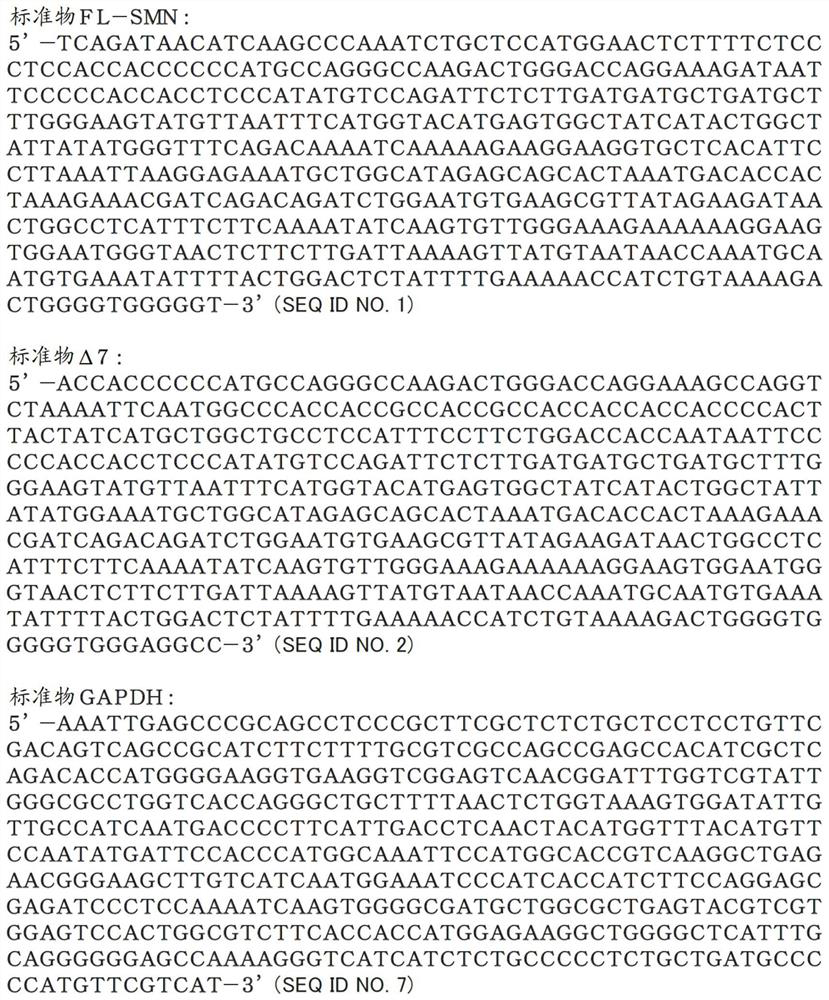Prophylactic or therapeutic agent for spinal muscular atrophy
A compound, C-R2 technology, applied in muscular system diseases, organic active ingredients, compound screening, etc., can solve problems such as protein reduction
- Summary
- Abstract
- Description
- Claims
- Application Information
AI Technical Summary
Problems solved by technology
Method used
Image
Examples
experiment Embodiment 1
[0406] [Experimental Example 1] Method for producing compound
[0407] The term "room temperature" in the following examples generally refers to about 10°C to about 35°C. The ratios used in mixed solvents are expressed by volume unless otherwise stated. Percentages are by weight unless otherwise indicated.
[0408] Fractions of the eluates were analyzed by thin-layer chromatography (TLC) while carrying out column chromatography in Examples unless otherwise stated. Specifically, using 60F 254 A plate (Merck) was used as a TLC plate, and the solvent used as an eluent for column chromatography was used as an eluent for TLC. A UV detector was used for detection. For silica gel column chromatography, the notation "NH" indicates the use of aminopropylsilane bound to silica gel, and the notation "Diol" indicates the use of 3-(2,3-dihydroxypropoxy)propylsilane bound to silica gel. For preparative high performance liquid chromatography (HPLC), the notation "C18" indicates the use ...
Embodiment 1
[0443] 2-(4,6-Dimethylpyrazolo[1,5-a]pyrazin-2-yl)-7-fluoro-6-(1-methylpiperidin-4-yl)quinazoline- 4(3H)-keto
[0444] (A) 2-Amino-4-fluoro-5-(1-methylpiperidin-4-yl)benzamide
[0445]
[0446] Stirring 2-amino-5-bromo-4-fluorobenzamide (820 mg), 1-methyl-4-(4,4,5,5-tetramethyl-1,3,2-di Oxaborolan-2-yl)-1,2,3,6-tetrahydropyridine (942 mg), bis[di-tert-butyl(4-dimethylaminophenyl)phosphine]dichloropalladium(II) (237 mg), 2.0M aqueous sodium carbonate solution (5.28 mL) and toluene (15 mL) overnight. To the resulting mixture was added water at room temperature, and the mixture was extracted with ethyl acetate. The organic layer was separated, washed with saturated brine, dried over anhydrous magnesium sulfate, and the volatile components were distilled off under reduced pressure. The remaining solid was purified by silica gel column chromatography (NH, methanol / ethyl acetate). To the obtained solid were added palladium hydroxide on activated carbon (20% palladium) (100 m...
Embodiment 2
[0477] 2-(4,6-Dimethylpyrazolo[1,5-a]pyrazin-2-yl)-6-(1-methylpiperidin-4-yl)quinazoline-4(3H) -ketone
[0478] (A) 2-Amino-5-(1-methylpiperidin-4-yl)benzamide
[0479]
[0480]2-Amino-5-bromobenzamide (2.7g), 1-methyl-4-(4,4,5,5-tetramethyl-1,3,2-dioxaborolane-2 -yl)-1,2,3,6-tetrahydropyridine (3.36g), bis[di-tert-butyl(4-dimethylaminophenyl)phosphine]dichloropalladium(II) (845mg), 2.0M carbonic acid A mixture of aqueous sodium solution (18.8 mL) and toluene (50 mL) was stirred at 100°C overnight. Water was added to the mixture at room temperature, and the mixture was extracted with ethyl acetate. The organic layer was separated, washed with saturated brine, dried over anhydrous magnesium sulfate, and the volatile components were distilled off under reduced pressure. The remaining solid was purified by silica gel column chromatography (NH, ethyl acetate / hexane and NH, methanol / ethyl acetate), and then palladium hydroxide-activated carbon (20% palladium) (160 mg) and me...
PUM
 Login to view more
Login to view more Abstract
Description
Claims
Application Information
 Login to view more
Login to view more - R&D Engineer
- R&D Manager
- IP Professional
- Industry Leading Data Capabilities
- Powerful AI technology
- Patent DNA Extraction
Browse by: Latest US Patents, China's latest patents, Technical Efficacy Thesaurus, Application Domain, Technology Topic.
© 2024 PatSnap. All rights reserved.Legal|Privacy policy|Modern Slavery Act Transparency Statement|Sitemap



